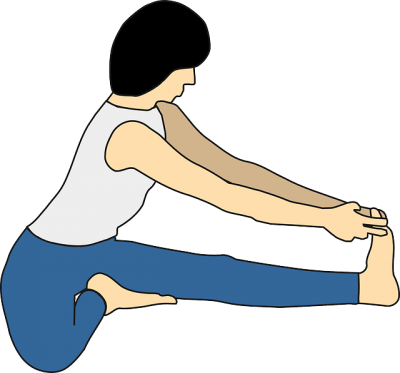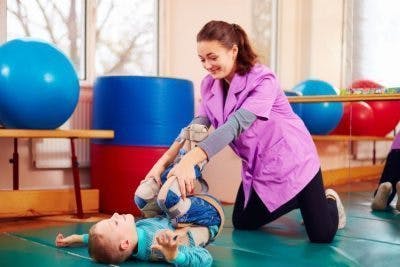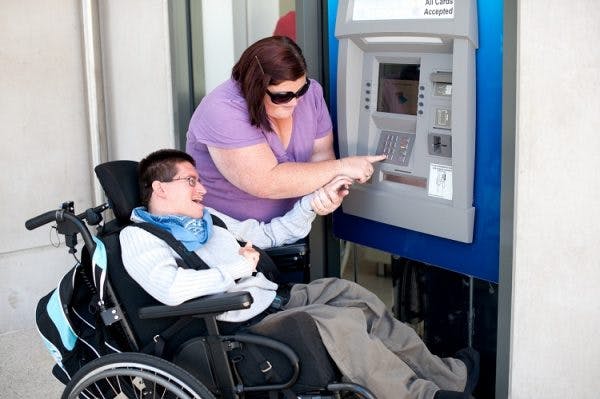The most effective stretches for individuals with cerebral palsy focus on lengthening spastic muscles. This is essential because lack of stretching can cause spasticity to increase, leading to more restricted movement over time.
This article will explain the benefits of stretching and provide stretches that individuals with mild cerebral palsy can practice at home.
Why Stretching is Necessary for Cerebral Palsy Management
Over 80% of people with cerebral palsy experience involuntary muscle contractions called spasticity. When muscles continuously contract, they constantly pull on the joints and limit range of motion.
Children are continuously growing, and unmanaged spasticity can cause abnormal posture, stiff movements, and inhibit muscle growth. Stretching can help elongate tight muscles and connective tissues to relieve strain on the joints and improve range of motion.
Individuals with more severe forms of cerebral palsy may need to utilize medications like Botox or baclofen to reduce spasticity enough to effectively stretch the muscles.
Goals of stretching include:
- Stabilizing muscle tone
- Maintaining or increasing range of motion
- Reducing pain
- Deferring surgery
Want 19 pages of CP recovery tips in PDF form? Click here to download our free illustrated ebook now (link opens a pop up for uninterrupted reading)
Stretches for Cerebral Palsy
Depending on the severity of cerebral palsy and the child’s age, various stretching strategies may be recommended including:
- Passive stretching: Stretching performed by another person that does not require effort by the child. Parents with very young children or children with severe motor impairments will likely need to stretch their child’s muscles passively.
- Active stretching: Stretching initiated and/or maintained by the child. If your child has enough motor control, active stretching is ideal.
- Prolonged positioning: Positioning used to stretch a muscle for a longer duration.
These stretching strategies are often utilized with other spasticity management interventions including orthoses, surgery, or medications.
Listed below are the 7 stretches that individuals with mild cerebral palsy can actively practice at home. Have your child hold the stretches for about 30 seconds and then switch sides.
1. Hamstring Stretch

Sit on the floor with one leg straightened and the other leg bent so that the bottom of your foot touches the side of your straightened leg. Slowly lean forward towards the foot of the straightened leg and hold.
2. Heel Cord Wall Stretch
While standing, face a wall and place both hands on the wall shoulder-width apart. Take a large step back with one leg so you’re standing on the ball of the foot. Slowly, press your heel down (the front leg should bend as you go down) and hold.
3. Seated Heel Cord Stretch
For the following stretch, you’ll need a belt, towel, or resistance band. Sit on the ground with one leg straight and the other bent. Loop the belt around the bottom of your straightened leg’s foot and slowly pull the ends toward your body, always staying in a pain free range
4. Quadriceps Stretch
Sit with one leg straightened in front of you and the other bent back. Slowly lean back, using your forearms for support and hold while maintaining a relaxed position.
5. Knee to Chest Stretch

Lay on your back with one leg straight and the other bent so that your knee points upward. Lift the bent leg, pull the knee up towards your chest, and hold.
6. Wrist Stretch

Raise one arm in front of you with your palm facing down. Use your other hand to gently pull the palm up and in towards the body, so that the wrist bends back. Be aware that the bend should be from the wrist, not the fingers. Next, pull the palm down, so that the wrist bends forward.
An alternative way to perform this stretch is to place your palm on your seat, keep the arm straight, and gently shift some of your weight onto the hand. Then, flip your hand to the other side so that the back of the hand is on the seat and gently shift your weight.
7. Shoulder Stretch
Open one arm out against a wall and slowly twist your body in the opposite direction. For example, if your right arm is against the wall, twist your body to the left.
Now that we’ve covered various stretches a child with cerebral palsy may be able to practice, let’s discuss the importance of orthoses for passive stretching.
Orthoses for Passive Stretching

The effects of a daily stretching session may not be effective for long-term spasticity relief. Braces, splints, and casts combat spastic muscles by promoting correct musculoskeletal alignment and prolonged passive stretching, even when the individual is not actively exercising.
Serial casting involves continuously wearing a cast for up to a week. Every week (for up to 12 weeks), the cast is replaced to continue the lengthening outcomes of the previous cast.
Our muscles are visco-elastic, meaning that when you hold a stretch for a long time, the amount of tension for that given length is eventually going to decrease.
Serial casting gently stretches the muscle and allows sufficient time for tension to decrease so that the muscle can be further lengthened for the same amount of tension with the next cast.
Individuals with cerebral palsy require stretching prior to bracing or serial casting. If orthoses are worn without stretching, they may not fit correctly or may be more painful during wear.
Wearing orthoses and stretching regularly requires time and commitment. As children get older, they may become resistant for many reasons. In the following section, we’ll offer suggestions for encouraging your child to stretch and wear their orthoses.
How to Get Children with Cerebral Palsy to Stretch

To help your child develop a habit of stretching daily, have them stretch at the same time each day, such as after breakfast or before bed. Instead of feeling forced to stretch, children may consider it as part of their daily routine.
Practicing the same stretches every day may decrease interest and motivation. One way to encourage regular stretching is to creatively incorporate stretching into recreational activities. Then stretching becomes fun and keeps children engaged.
Examples of games you can play with your child to promote stretching include:
- Simon Says. Incorporating stretches into a game of Simon Says can be an effective way to get your child to stretch more often. For example, “Simon Says sit like this and count to 20.”
- Mirroring. Tell your child to copy everything you do. Include stretches, funny faces, and dance moves to make the game more fun.
- Rock, Paper, Scissors, Splits. Play rock, paper, scissors, but with a twist: the loser has to take a step back. Each time someone loses, they need to take another step back until someone loses balance. This movement stretches the hip flexors and hamstrings.
Another way to motivate your child is to create a reward system. For example, if they stretch every day for 1 week, they can have a special dessert; if they stretch every day for 2 weeks, they can pick a toy. This teaches your child how to set achievable goals and work towards them.
Ultimately, it comes downs to knowing your child, their interests, and what motivates them.
Cerebral Palsy and Stretching: Key Points
Muscle lengthening requires consistency and frequency. Stretching won’t eliminate spasticity, but it may limit its tightness.
As a preventive measure, individuals with mild cerebral palsy should stretch daily to maintain range of motion.
Hopefully, this article helped you understand why it’s important for people with cerebral palsy to incorporate stretching into their daily routines.











